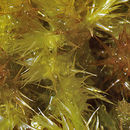Comprehensive Description
provided by North American Flora
Ceratodon purpureus (L.) Brid. Bryol. Univ. 1: 480. 1826
Mnium purpureum L. Sp. PI. 1111. 1753.
Dicranum purpurascens Hedw. Sp. Muse. 137. 1801.
Didymodon purpurascens Hook. & Tayl. Muse. Brit. 65. 1818.
Ceratodon purpureus aristatus Aust. Musci App. 22. 1870.
Ceratodon purpureus xanlhopus Sull. & Lesq. (Musci Bor. Am. 29; hyponym. 1865); S. Wats. Hot.
Calif. 2:365. 1880. Ceratodon helerophyllus Kindb. Ottawa Nat. 5: 179. 1892. Ceratodon Columbiae Kindb. Rev. Bryol. 23: 20. 1896. Plants perennial, very variable in size and habit; stems usually cespitose, short and crowded, rarely taller, lax and branching, with slender, subapical, dichotomous or fastigiate innovations: leaves incurv-ed and twisted when dry, 1-1.5 mm. long, lanceolate, acuminate or subulate, entire, or serrulate at the apex; margins revolute; costa thick, ending in the apex or excurrent; cells small, rounded or square, the lower ones slightly longer, the alar oblong and slightly decurrent; perichaetium erect, sheathing, its leaves longer, paler, mucronate or often blunt or retuse at the apex. Dioicous: antheridia terminal on more slender plants: seta usually purple, or in certain forms pale-yellow or red, glossy, 1-4 cm. long, erect and twisted: calyptra cucullate: capsule erect, becoming horizontal, sulcate, and usually dark-colored when mature, 1-2 mm., rarely 3 mm. long, glossy and curved when dry; neck abrupt, strumose; lid short, conic or beaked; annulus of 2-4 rows of cells; peristome exserted on a short basal membrane, paleor dark-red; teeth bifid, closely jointed, dark-brown and trabeculate at the base, paler and papillose above, and incurved when dry, bordered by the paler inner lamellae, thickened and more or less united at the lower joints: spores 10-16 m in diameter, maturing from April to September.
Type uoc.lity: Europe.
Distribution: Cosmopolitan. A common and variable species found in many different habitats from sea level to alpine stations and from the tropics to Arctic America, including Alaska and Greenland. Over fifty synonyms and many forms have been recorded, which the most critical Euroi>ean bryologists are disposed to consider only as varieties or subspecies. Comparisons have been carefully made and we find the following atypical North American forms worthy of note:
Plants small; stems short, often julaceous or filiform. (Arctic.)
Leaves erect-appressed, ovate, acute. (Yukon Territory.) f. brevifoUus.
Leaves incurved-appressed, ovate or lancolate, blunt or acuminate. (Agattu and
St. Paul Islands, Behring Sea.) f. heterophyllus.
Plants taller, often paler; seta yellow; leaves acute or acuminate. (Xerophytic.)
Costa excurrent. (Maine to New Jersey.) f. aristaius.
Costa percurrent ; lid sometimes beaked. (Georgia to Missoiui, Montana to New
Mexico, Washington to California.) f. xanthopus.
- bibliographic citation
- Albert LeRoy Andrews, Elizabeth Gertrude Britton, Julia Titus Emerson. 1961. SPHAGNALES-BRYALES; SPHAGNACEAE; ANDREAEACEAE, ARCHIDIACEAE, BRUCHIACEAE, DITRICHACEAE, BRYOXIPHIACEAE, SELIGERIACEAE. North American flora. vol 15(1). New York Botanical Garden, New York, NY

